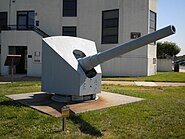| José González Hontoria | |
|---|---|
 A portrait of José González Hontoria by Eulogia Merle | |
| Born | July 21, 1840 |
| Place of birth | Sanlúcar de Barrameda |
| Place of death | Cadiz |
| Buried at | Panteón de Marinos Ilustres |
| Allegiance | Spain |
| Service/branch | Naval Infantry |
| Rank | Field Marshal |
| Awards | Order of Charles III |
José González Hontoria (born 21 July 1840, Sanlúcar de Barrameda, Cadiz—d. 1889, Carabanchel, Madrid) was a Spanish inventor, field marshal of the marine infantry and brigadier of the navy.
Biography[]
At nine years old he entered the Military Naval College of San Fernando on 31 December 1851 as a midshipman. On 11 March 1858 he was commissioned as a student sublieutenant of the Academy of the Royal Corps of Artillery of the Navy from which he graduated in 1860 as a lieutenant and on 4 September was named assistant professor of the academy. He was sent by superiors on a path of learning and apprenticeship for the manufacture of gunpowder and arms, as well as to study the processes for the foundation of national industry. On 31 January 1861 he returned to his work as a professor.
From 17 August 1863 he again took command of the School and Branch of Naval Gunners, of which he was the most senior professor.
He made several studies about procedures for the production of gunpowder and the manufacture of artillery. In 1879 the artillery system which he created was accepted for service in the navy and he was designated to study the system of manufacture of calibers, the design of guns and projectiles. He performed numerous missions of service in Spain and abroad.
He was made very good offers by English cannon manufacturers to be the manager, but he did not accept them because he preferred to render his services to Spain.
He designed diverse types of guns for the Spanish Navy, among them the so-called Trubia, a model of 160mm gun that in those times was considered the most powerful in Europe. He also designed 240mm, 280mm, and 320mm guns as armaments for ships of the navy.
He was buried at the Pantheon of Illustrious Mariners on 8 July 1907.
Gallery[]
External links[]
- «El Brigadier González Hontoria». Vida marítima (July 2008). Retrieved 14 July 2012.
- José González Hontoria Retrieved 3 February 2015
- Photos of a captured 140mm Gonzáles Hontoria rapid-fire gun.
The original article can be found at José González Hontoria and the edit history here.


